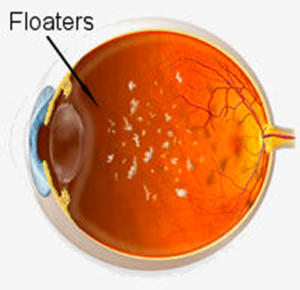BOOK ONLINE NOW
Spots and floaters are semi-transparent specks of natural materials inside the eye, which may appear to drift or float across your field of vision.
Some patients say that they look like cobwebs or threads, and they can be particularly noticeable when looking at a plain, bright background like a white wall or clear sky. Interestingly, while they may seem to be in front of the eye, they are actually floating inside it!
Spots and floaters become more common as we age – but the good news is they are usually harmless and do not require treatment.
However, if they are affecting your vision or if you are seeing flashes in the eye it may indicate a more serious problem, so it’s important to see your local optometrist for a thorough eye exam.

Spots and floaters

Spots and floaters detail
Spots and floaters are caused by tiny bits of material that clump together within the vitreous, the clear, gel-like substance inside your eye attached to your retina. As we age, the vitreous tends to liquefy and shrink, leading to the formation of these clumps. The shadows these clumps cast on the retina are what you perceive as floaters.
Often the cause is simply the natural ageing process; however if flashes or ‘stars’ accompany the floaters and spots, the cause may be:
In most cases, floaters are harmless. However, there are certain symptoms that require urgent attention:
For most people, no treatment is necessary (1).
However if they are significantly interfering with your vision, our experienced optometrists might suggest one of the following treatments:
Regular eye exams are crucial for maintaining eye health and catching any potential problems early. If you are at all concerned about spots or floaters, a full eye examination will determine the cause and whether any follow-up is needed. Please don’t hesitate to book an eye exam with our highly experienced optometrists in Brisbane today!
© 2025 Aphrodite Livanes Optometrist Brisbane: Eye Care Plus. All rights reserved.